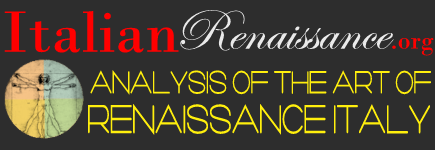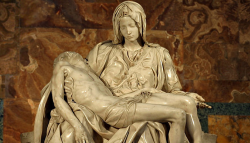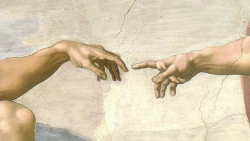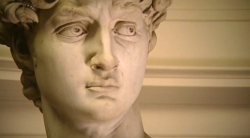From the Lives of the Most Excellent Italian Painters, Sculptors, and Architects, by Giorgio Vasari.
Life of Giotto (1267-1337)
That very obligation which the craftsmen of painting owe to nature, who serves continually as model to those who are ever wresting the good from her best and most beautiful features and striving to counterfeit and to imitate her, should be owed, in my belief, to Giotto, painter of Florence, for the reason that, after the methods of good paintings and their outlines had lain buried for so many years under the ruins of the wars, he alone, although born among inept craftsmen, by the gift of God revived that art, which had come to a grievous pass, and brought it to such a form as could be called good. And truly it was a very great miracle that that age, gross and inept, should have had strength to work in Giotto in a fashion so masterly, that design, whereof the men of those times had little or no knowledge, was restored completely to life by means of him. And yet this great man was born at the village of Vespignano, in the district of Florence, fourteen miles distant from that city, in the year 1276, from a father named Bondone, a tiller of the soil and a simple fellow. He, having had this son, to whom he gave the name Giotto, reared him conformably to his condition; and when he had come to the age of ten, he showed in all his actions, although childish still, a vivacity and readiness of intelligence much out of the ordinary, which rendered him dear not only to his father but to all those also who knew him, both in the village and beyond. Now Bondone gave some sheep into his charge, and he, going about the holding, now in one part and now in another, to graze them, and impelled by a natural inclination to the art of design, was for ever drawing, on stones, on the ground, or on sand, something from nature, or in truth anything that came into his fancy. Wherefore Cimabue, going one day on some business of his own from Florence to Vespignano, found Giotto, while his sheep were browsing, portraying a sheep from nature on a flat and polished slab, with a stone slightly pointed, without having learnt any method of doing this from others, but only from nature; whence Cimabue, standing fast all in a marvel, asked him if he wished to go to live with him. The child answered that, his father consenting, he would go willingly. Cimabue then asking this from Bondone, the latter lovingly granted it to him, and was content that he should take the boy with him to Florence; whither having come, in a short time, assisted by nature and taught by Cimabue, the child not only equalled the manner of his master, but became so good an imitator of nature that he banished completely that rude Greek manner and revived the modern and good art of painting, introducing the portraying well from nature of living people, which had not been used for more than two hundred years. If, indeed, anyone had tried it, as has been said above, he had not succeeded very happily, nor as well by a great measure as Giotto, who portrayed among others, as is still seen to-day in the Chapel of the Palace of the Podestà at Florence, Dante Alighieri, a contemporary and his very great friend, and no less famous as poet than was in the same times Giotto as painter, so much praised by Messer Giovanni Boccaccio in the preface to the story of Messer Forese da Rabatta and of Giotto the painter himself. In the same chapel are the portraits, likewise by the same man’s hand, of Ser Brunetto Latini, master of Dante, and of Messer Corso Donati, a great citizen of those times.
The first pictures of Giotto were in the chapel of the high-altar in the Badia of Florence, wherein he made many works held beautiful, but in particular a Madonna receiving the Annunciation, for the reason that in her he expressed vividly the fear and the terror that the salutation of Gabriel inspired in Mary the Virgin, who appears, all full of the greatest alarm, to be wishing almost to turn to flight. By the hand of Giotto, likewise, is the panel on the high-altar of the said chapel, which has been preserved there to our own day, and is still preserved there, more because of a certain reverence that is felt for the work of so great a man than for any other reason. And in S. Croce there are four chapels by the same man’s hand: three between the sacristy and the great chapel, and one on the other side. In the first of the three, which is that of Messer Ridolfo de’ Bardi, and is that wherein are the bell-ropes, is the life of S. Francis, in the death of whom a good number of friars show very naturally the expression of weeping. In the next, which is that of the family of Peruzzi, are two stories of the life of S. John the Baptist, to whom the chapel is dedicated; wherein great vivacity is seen in the dancing and leaping of Herodias, and in the promptness of some servants bustling at the service of the table. In the same are two marvellous stories of S. John the Evangelist—namely, when he brings Drusiana back to life, and when he is carried off into Heaven. In the third, which is that of the Giugni, dedicated to the Apostles, there are painted by the hand of Giotto the stories of the martyrdom of many of them. In the fourth, which is on the other side of the church, towards the north, and belongs to the Tosinghi and to the Spinelli, and is dedicated to the Assumption of Our Lady, Giotto painted her Birth, her Marriage, her Annunciation, the Adoration of the Magi, and when she presents Christ as a little Child to Simeon, which is something very beautiful, seeing that, besides a great affection that is seen in that old man as he receives Christ, the action of the child, stretching out its arms in fear of him and turning in terror towards its mother, could not be more touching or more beautiful. Next, in the death of the Madonna herself, there are the Apostles, and a good number of angels with torches in their hands, all very beautiful. In the Chapel of the Baroncelli, in the said church, is a panel in distemper by the hand of Giotto, wherein is executed with much diligence the Coronation of Our Lady, with a very great number of little figures and a choir of angels and saints, very diligently wrought. And because in that work there are written his name and the date in letters of gold, craftsmen who will consider at what time Giotto, with no glimmer of the good manner, gave a beginning to the good method of drawing and of colouring, will be forced to hold him in the highest veneration. In the same Church of S. Croce, over the marble tomb of Carlo Marsuppini of Arezzo, there is a Crucifix, with the Madonna, S. John, and Magdalene at the foot of the Cross; and on the other side of the church, exactly opposite this, over the burial-place of Lionardo Aretino, facing the high-altar, there is an Annunciation, which has been recoloured by modern painters, with small judgment on the part of him who has had this done. In the refectory, on a Tree of the Cross, are stories of S. Louis and a Last Supper by the same man’s hand; and on the wardrobes in the sacristy are scenes with little figures from the life of Christ and of S. Francis. He wrought, also, in the Church of the Carmine, in the Chapel of S. Giovanni Battista, all the life of that Saint, divided into a number of pictures; and in the Palace of the Guelph party, in Florence, there is a story of the Christian Faith, painted perfectly in fresco by his hand; and therein is the portrait of Pope Clement IV, who created that magisterial body, giving it his arms, which it has always held and holds still.
After these works, departing from Florence in order to go to finish in Assisi the works begun by Cimabue, in passing through Arezzo he painted in the Pieve the Chapel of S. Francesco, which is above the place of baptism; and on a round column, near a Corinthian capital that is both ancient and very beautiful, he portrayed from nature a S. Francis and a S. Dominic; and in the Duomo without Arezzo he painted the Stoning of S. Stephen in a little chapel, with a beautiful composition of figures. These works finished, he betook himself to Assisi, a city of Umbria, being called thither by Fra Giovanni di Muro della Marca, then General of the Friars of S. Francis; where, in the upper church, he painted in fresco, under the gallery that crosses the windows, on both sides of the church, thirty-two scenes of the life and acts of S. Francis—that is, sixteen on each wall—so perfectly that he acquired thereby very great fame. And in truth there is seen great variety in that work, not only in the gestures and attitudes of each figure but also in the composition of all the scenes; not to mention that it enables us very beautifully to see the diversity of the costumes of those times, and certain imitations and observations of the things of nature. Among others, there is one very beautiful scene, wherein a thirsty man, in whom the desire for water is vividly seen, is drinking, bending down on the ground by a fountain with very great and truly marvellous expression, in a manner that it seems almost a living person that is drinking. There are also many other things there most worthy of consideration, about which, in order not to be tedious, I do not enlarge further. Let it suffice that this whole work acquired for Giotto very great fame, by reason of the excellence of the figures and of the order, proportion, liveliness, and facility which he had from nature, and which he had made much greater by means of study, and was able to demonstrate clearly in all his works. And because, besides that which Giotto had from nature, he was most diligent and went on ever thinking out new ideas and wresting them from nature, he well deserved to be called the disciple of nature and not of others. The aforesaid scenes being finished, he painted in the same place, but in the lower church, the upper part of the walls at the sides of the high-altar, and all the four angles of the vaulting above in the place where lies the body of S. Francis; and all with inventions both fanciful and beautiful. In the first is S. Francis glorified in Heaven, surrounded by those virtues which are essential for him who wishes to be perfectly in the grace of God. On one side Obedience is placing a yoke on the neck of a friar who is before her on his knees, and the bands of the yoke are drawn by certain hands towards Heaven; and, enjoining silence with one finger to her lips, she has her eyes on Jesus Christ, who is shedding blood from His side. And in company with this virtue are Prudence and Humility, in order to show that where there is true obedience there are ever humility and prudence, which enable us to carry out every action well. In the second angle is Chastity, who, standing in a very strong fastness, is refusing to be conquered either by kingdoms or crowns or palms that some are presenting to her. At her feet is Purity, who is washing naked figures; and Force is busy leading people to wash and purify themselves. Near to Chastity, on one side, is Penitence, who is chasing Love away with a Discipline, and putting to flight Impurity. In the third space is Poverty, who is walking with bare feet on thorns, and has a dog that is barking at her from behind, and about her a boy who is throwing stones at her, and another who is busy pushing some thorns with a stick against[Pg 76] her legs. And this Poverty is seen here being espoused by S. Francis, while Jesus Christ is holding her hand, there being present, not without mystic meaning, Hope and Compassion. In the fourth and last of the said spaces is a S. Francis, also glorified, in the white tunic of a deacon, and shown triumphant in Heaven in the midst of a multitude of angels who are forming a choir round him, with a standard whereon is a Cross with seven stars; and on high is the Holy Spirit. Within each of these angles are some Latin words that explain the scenes. In like manner, besides the said four angles, there are pictures on the side walls which are very beautiful and truly to be held in great price, both by reason of the perfection that is seen in them and because they were wrought with so great diligence that up to our own day they have remained fresh. In these pictures is the portrait of Giotto himself, very well made, and over the door of the sacristy, by the same man’s hand and also in fresco, there is a S. Francis who is receiving the Stigmata, so loving and devout that to me it appears the most excellent picture that Giotto made in these works, which are all truly beautiful and worthy of praise.



